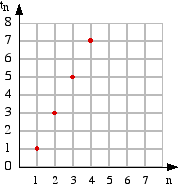 A sequence is a set of numbers arranged in a particular order.
A sequence is a set of numbers arranged in a particular order.
Sequences can be:
finite, a fixed number of terms e.g 3, 4
or
infinite, going on forever e.g. 3, 4, 5, 6,...
This course studies infinite sequences.
Many sequences have a mathematical pattern.
Arithmetic and Geometric sequences are examples of sequences with a patterns and are studied in the next two topics. Sequences can be enclosed in triangular brackets. <3, 4, 5...>
Notation
Each number in a sequence is called a term. There are various ways of describing terms.
The first term of a sequence can be given by t1, t(1), T(1) or T1. We will use t1.
The general term or n th term is written as t n.
There are four ways to express a sequence.
|
Method
|
Explanation
|
Example
|
| By listing | List the first four or five terms in order. | 2, 8, 23, 68... |
| By formula for the nth term |
A formula is provided to work out any term of the sequence. This activity will help you to work out the formula for sequences. |
<3n + 2> or tn = 3n + 2 First term, t1 = 3 x 1 + 2 = 5Second term, t2 = 3 x 2 + 2 = 8 Third term t3 = 3 x 3 + 2 = 11 etc. The sequence is 5, 8, 11... |
| By a recursive function |
One term is provided and a formula is given to work out the following term. |
t 1 = 3 ,t n + 1 = 2 t n + 1 First term is 3 The sequence is 3, 7, 15... |
| By graphing |
The sequence is illustrated on a graph. The horizontal axis is the number of the term. The vertical axis is the term itself. |
Graph < 1, 3, 5, 7... >
|
